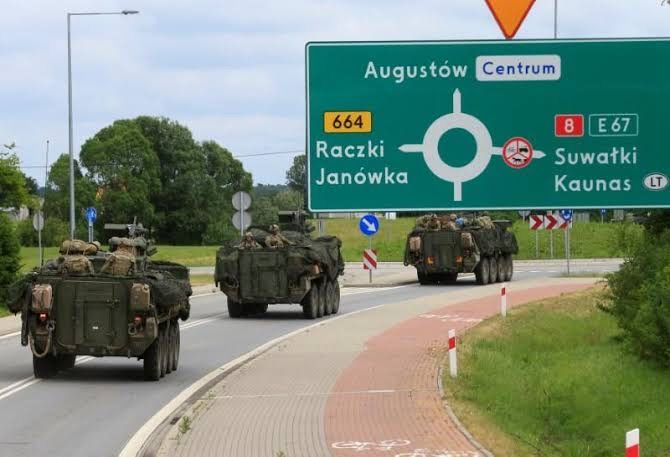The Suwalki Corridor: A Potential Flashpoint for World War III
The Suwalki Corridor, also known as the Suwalki Gap, is a crucial passage of land that connects the European Union with the Baltic States. This narrow strip of land runs along the border between Poland and Lithuania and serves as the only land connection between these two EU members. As

The Suwalki Corridor, also known as the Suwalki Gap, is a crucial passage of land that connects the European Union with the Baltic States. This narrow strip of land runs along the border between Poland and Lithuania and serves as the only land connection between these two EU members. As a result, the Suwalki Corridor has gained immense strategic importance in recent years and is being viewed as a hot spot for geopolitical tensions.
The Suwalki Corridor runs for approximately 104 kilometers and is just 65 kilometers wide at its broadest point. It has become a vital transit point for goods and services being transported between the Baltic States and the rest of the European Union. Additionally, it serves as a critical transportation link for NATO forces stationed in the region.
Now, more than ever, the Suwalki Corridor is under the spotlight. As the West continues to feel pressure from Russia, the Suwalki Corridor has become a vulnerable point for NATO member countries. In fact, due to its tactical significance, the Suwalki Corridor has been described by some as the "Achilles heel" of NATO forces.
The Suwalki Gap is situated between the Kaliningrad region and Belarus, currently two hotspots for Russian military activities. As a result, the Suwalki Corridor is seen as the easiest point of entry for Russian troops into the Baltic States. In addition, the abduction of a Polish soldier in that area in 2016 and the simulated seizure of a city during a Russian military exercise in 2017 shows how easily the Suwalki Corridor could be used to disrupt the Western alliance by Russian forces.
To counter these threats, the United States and NATO forces have launched a series of military exercises in the region. The objective of such exercises is to prepare for possible attacks and safeguard the Suwalki Corridor.
On the other hand, the public sector is also taking notice of the Suwalki Corridor. Extra funds have been allocated to expand infrastructure, including highways, border crossings, and fibre-optic cables running through the region. Additionally, there are currently discussions taking place between France and Poland to connect the Suwalki Corridor with a planned high-speed train line between Helsinki and Warsaw, further strengthening the economic integration of the Baltic States with the rest of the European Union.
But what does all of this mean for businesses operating in the region?
The Suwalki Corridor offers a unique opportunity for businesses to capitalize on a rapidly growing market. Situated at the heart of Europe, the Suwalki Corridor is an essential transit point for goods and services. As the region continues to become more integrated with the rest of Europe, businesses operating in or near the Corridor stand to reap significant benefits.
Importantly, the Suwalki Corridor is one of the most economically attractive regions in Poland. It offers businesses an opportunity to tap into a growing and vibrant consumer market, with a GDP per capita above the Polish average. Furthermore, the region enjoys favorable tax conditions, government incentives, and abundant labor resources.
The Suwalki Corridor is home to a wide range of industries, including electronics, machinery, and paper production, among others. In addition, the region has a thriving agricultural sector, producing everything from potatoes to strawberries, which provides a valuable potential market for related industries, including food processing and distribution. Companies in the technology and IT sector are also discovering the Suwalki Corridor's potential, as the region boasts state-of-the-art data centers and fiber-optic infrastructure.
Outside of individual industries, the Suwalki Corridor provides businesses with opportunities to expand into other markets in the region. Lithuania and Latvia, in particular, are markets that companies operating in the Suwalki Corridor can easily access. With the Baltic States enjoying some of the highest growth rates in Europe, investing in the Suwalki Corridor can provide companies with potential growth opportunities that they may not otherwise have considered.
The Suwalki Corridor is a crucial economic and geopolitical point for the Central and Eastern European region. As unrest continues to stir in the area, NATO forces continue to train and prepare for potential conflicts, and businesses continue to seek market expansion opportunities. Its strategic importance cannot be understated, and the Suwalki Corridor is poised to become an essential hub for businesses looking to get ahead and expand their horizons. Businesses operating in the Suwalki Corridor can expect to have access to a growing market, favorable tax incentives, and opportunities to expand their operations into neighboring countries. Companies that move quickly and invest in the region today will be best positioned to capitalize on its potential for growth in the future.




